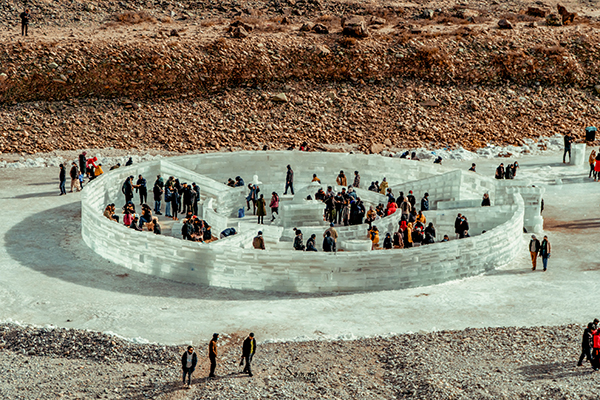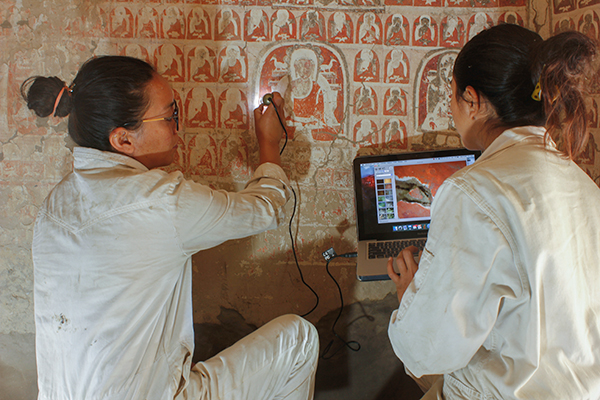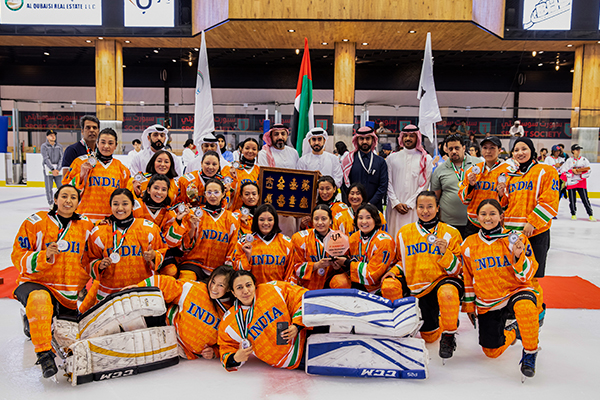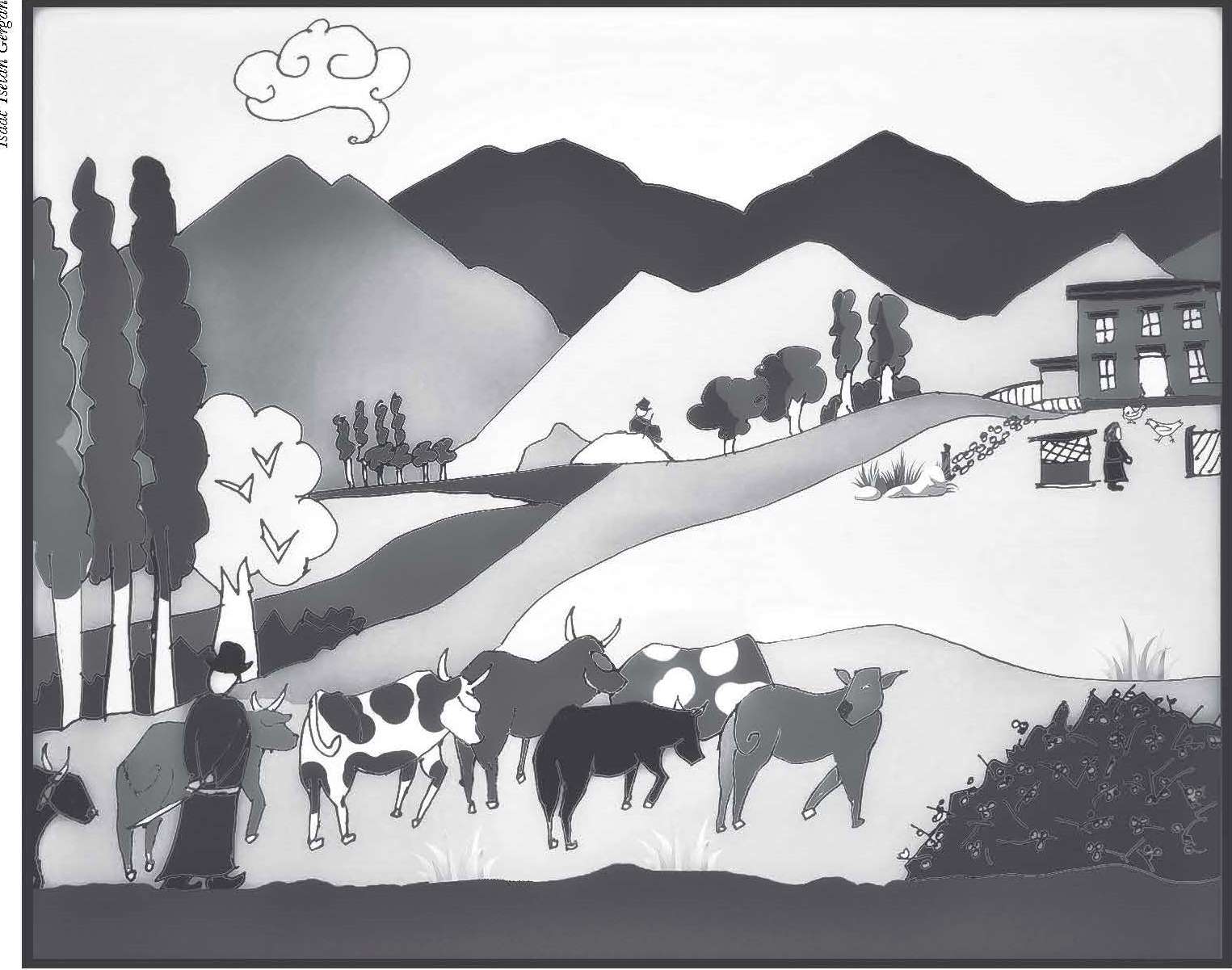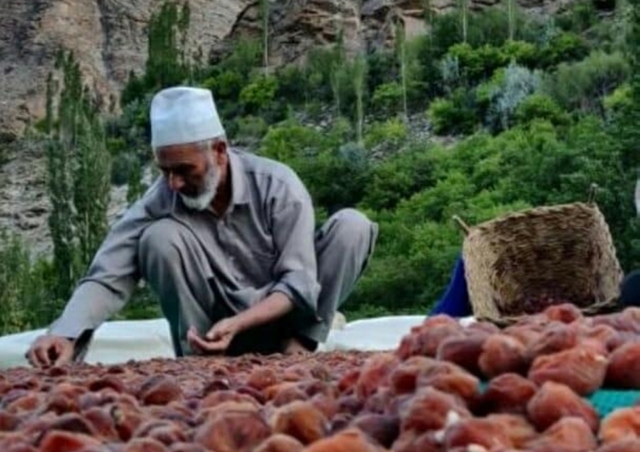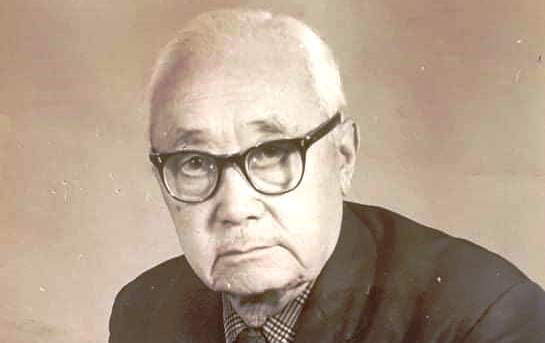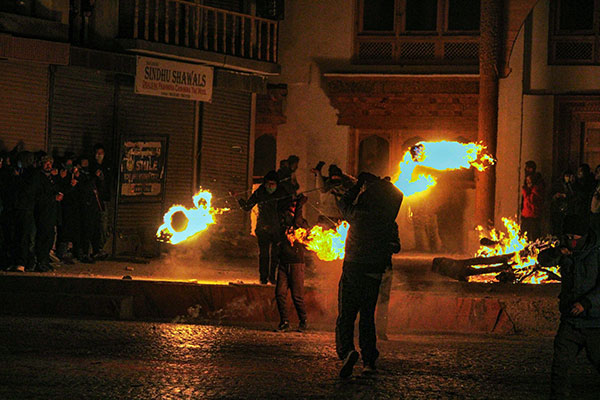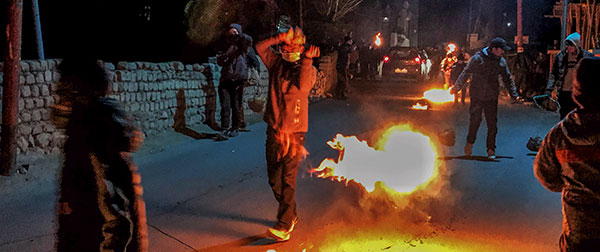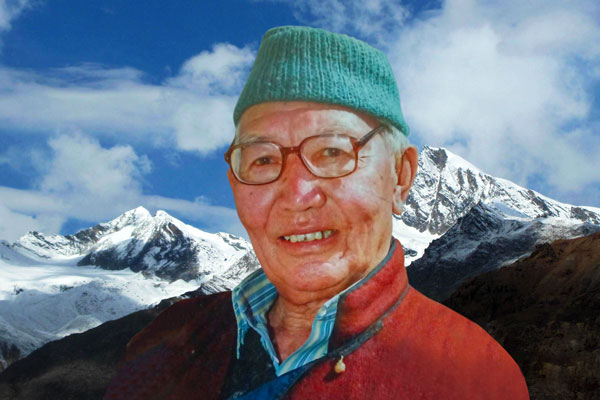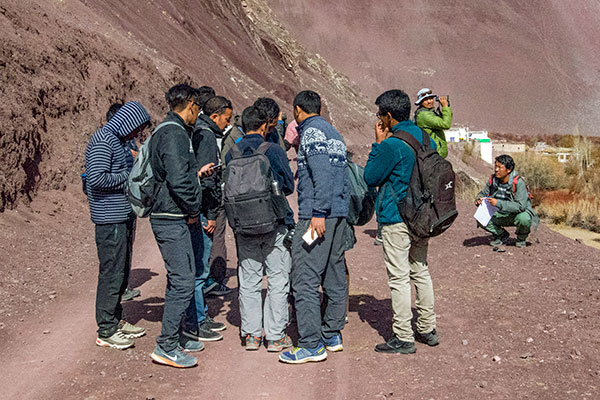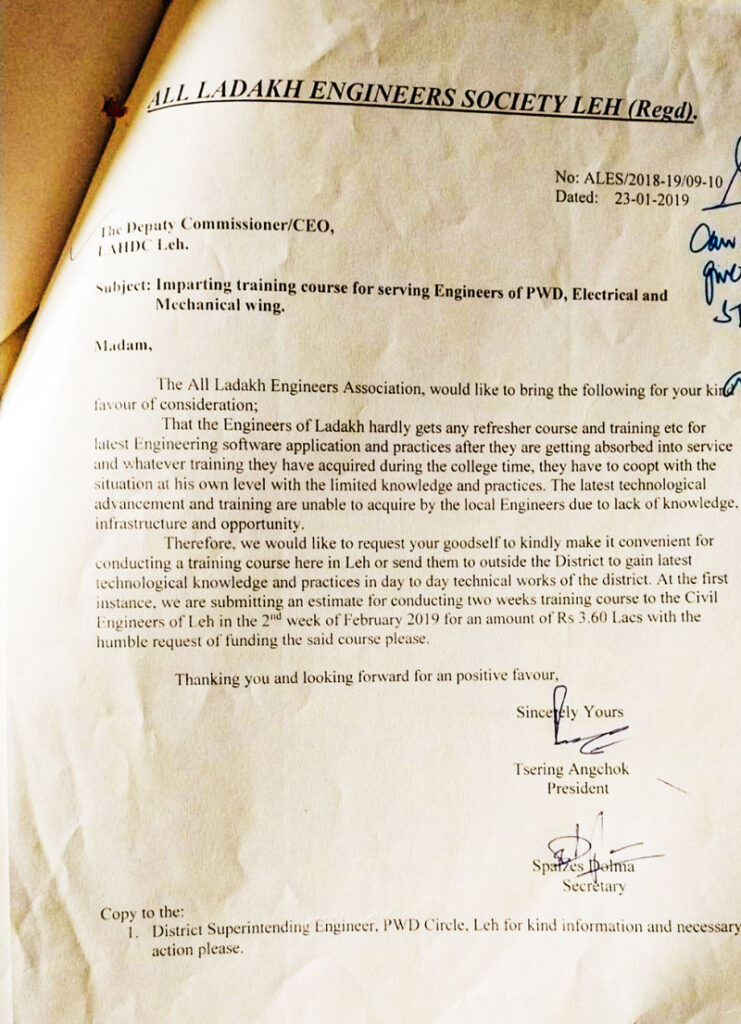I sat on an ice block cushioned with a Lokpa (goatskin fleece) and sipped hot tea. Portraits of Ladakh’s birds and mammals taken by local photographers were displayed on the ice walls. This unique space also had displays of metal products such as intricately designed pots and brass spoons from Chilling village.
The centrepiece was a snow leopard made from ice sitting on an ice pedestal in the middle of the ice café on the bank of the frozen Zangskar river. This space was a geometrical functional structure made completely from ice blocks. It had interactive spaces designed for a café along with exhibition spaces, which provided relief in the barren land.
This rugged river-bank is punctuated by a highway that leads to Zangskar valley. People rarely visit this area on cold wintry days. However, it has served as a ‘home’ to numerous Ladakhi artists between December 2021 and February 2022.
Hundreds of ice blocks were harvested from the frozen Zangskar river and used to create this structure. This is the result of the vision and hard work of Kangsing – Snow and Ice Sculpture Association of Ladakh. The members of this association are young Ladakhi artists practicing different art-forms such as contemporary sculpture, ceramics, painting, graphic design and traditional sculpture.
The association promotes snow and ice sculpture art in Ladakh, which can help boost winter tourism. Tsering Gyurmet, the President of Kangsing said that the people of Ladakh are fortunate to have ice and snow during winters. “Ladakh’s winter is cold and harsh, but we shouldn’t dread the winters. In fact, the cold winter months are a good opportunity to experiment and create new experiences. In our case, we have used ice to create an ice café,” he said.
The founding members of the Kangsing team include Chemat Dorjey, Tsering Gyurmet, Tashi Namgyal and Stanzin Nurboo. It was formed in 2018 to represent India at the International Ice Festival at Harbin, Beijing. During the event, they produced massive ice and snow sculptures of a Chorten (Stupa) and a yak and received recognition at the event.
Once they returned to Ladakh, they created several smaller ice sculptures in Leh bazaar while participating in events such as the Zanskar Winter Sports and Youth Festival 2021. They also experimented with small scale ice farming from the Indus. A part of this process was included in the form of a multimedia presentation during an exhibition called ‘How Much Water is Enough Water’ curated by Tsering Motup Siddho in 2019 at Ladakh Arts and Media Organisation, Leh (LAMO). They have expanded their experiments since. This winter they created an ice café structure through a workshop with more than 20 local artists. The workshop took place from 23 December 2021 to 10 February 2022. The Ice and Snow Sculpture Festival was then opened to the public from 11 to 18 February, 2022.
Chemat Dorjey, founding member and Secretary of Kangsing explained the reasons they undertook this task. “Many young artists in Ladakh are not employed full time and this provided them with an opportunity to come together on one platform to create artworks from ice—a medium that is easily available in Ladakh. The idea was to promote winter tourism and exhibit the skills of these artists. In addition, the workshop helped create awareness about climate change. In the past, winters were extremely cold with an abundance of snow. However, over the last few years, the winters have become warmer and there is little or no snow.”
Tashi Namgyal is a painter by profession and a founding member of the association. He said that it was challenging to work with ice. A team of porters from Zangskar and members of Kangsing cut ice blocks from the Indus. Initially they used sophisticated machines but they soon realised that the chainsaw was the only effective tool that worked for this task. They faced many challenges including constant breakdowns. “Nature is unforgiving. The ice blocks used for this project were bound to melt. The natural phenomenon of the water freezing to solid ice and then melting as it got warmer is natural,” he added. He explained that witnessing art using natural materials like ice shows the intangibility of nature. He felt that this project has the potential to create new opportunities for the people of Ladakh in the future.
Stanzin Motup, a traditional sculptor, was new to Kangsing. He worked with a large team for the first time and found the experience to be rewarding. He said, “Sculpture made out of ice, sends a very strong message about the impacts of climate change. The ice blocks used for the workshop are sustainable and a zero carbon emission material as the ice blocks were taken from the river and later melted back into it.”
Similarly, another new member, Phuntsog Namgyal stated that though he has worked with traditional art for many years, it was a new experience to sculpt with ice. In comparison to sculpting with clay, sculpting with ice had its own challenges. The task of transporting ice blocks from the riverbank to the site was difficult and labour-intensive. The most beneficial and wholesome experience was the process of exchanging ideas, experimentation with methods and the need for better understanding to work as a team. His fellow artist, Stanzin Gyalson also mentioned that learning the techniques of ice sculpting from senior sculptors was fulfilling. Initially, he thought the work was difficult but realised that it was relatively easy once he started working.
Like these artists, Tsering Youdol, a painter by profession and the only female member of Kangsing said that the workshop was a learning experience for her as it was the first time that she was working with ice. She hopes to work on bigger projects with ice in the future and urges more women to join Kangsing. She said, “I did not face any problems as the only woman in the team. I learnt a lot from the other members and feel that my experience will encourage more women artists to explore such collaborations in the future.”
Stanzin Nurboo, a traditional sculptor and Treasurer at Kangsing, explained that experiencing the cold winter months marked a changing phase in his life. He learnt the importance of coping with harsh climatic conditions and endured many challenges. He had previously participated in the Ice Festival at Harbin, Beijing.
Chemat explained, “We need to have bigger events in the future to promote winter tourism in Ladakh. Schools are closed during the winter and interested students can be trained to work with ice,” He added that voices of local communities are very important to address issues such as climate change. “We need to bring local communities together with glaciologists and scientists to create a more wholesome understanding of issues related to climate change. This could lead to development of new methods to conserve water and natural resources.”
This was echoed by Stanzin Wangail, a member of Kangsing, who explained that parents of students who learn art from him are very supportive and wanted their children to learn ice sculpture. “However, they were not able to participate this year due to COVID-19 and the extreme weather conditions at the site. I hope to conduct workshops for them next year,” he added.
Chemat envisions that in the coming years this event can take place at the national and as international level by inviting artists from outside the region. It could be in the form of an ice carnival that would include ice sculpture competition, snow sculpture competition, training workshops and various events for students and the public. This will help foster teamwork and promote art. It will also enhance Ladakh’s winter tourism festival calendar and generate monetary benefits for artists.
In 2022, a large number of people visited the café once the exhibition was opened for the public. “People wanted to experience the ice café before it melts. The most interesting thing was the surprise and satisfaction that people experienced. In a way, our work helped overcome the barrier of cold temperatures in the winter months. This was rewarding,” Chemat added.
I watched many young adults using the exquisite backdrop of the café for their social media videos. Similarly, many college students used it to take photographs, which helped make the café very popular online.
Tundup Dorjay, member of Kangsing, who stressed on the need to have organisers for such an event, “We were able to organise this workshop in 2021-22 with support from Dr. Norden Odzer, Stanzin Dawa and Stanzin Wangtak, who helped us with a number of tasks including logistics and event management. This allowed us to focus on our work at the site.”
Stanzin Dawa, an entrepreneur, spoke on the importance of being sustainable and financially independent. “The work of the Kangsing team is a first-of-its-kind in India. It was featured in The Week, covered in French media and included in the list of tourist destinations by the Ministry of Tourism, Government of India.” He envisions that an international conference can be held in Ladakh around this theme and that such a festival can help generate revenue during winter months when economic activities slow down especially in the wake of the pandemic.
The Hon’ble Lieutenant Governor of Ladakh, R. K. Mathur inaugurated the festival and visited the ice café. The event was collectively funded by Ladakh Police, Leh, District Commissioner, Leh, Tourism Department, Leh and various independent stakeholders including the Contractor Union and the Hotel and Guest House Association, Leh. The initial project outlay was for Rs 65 lakh (Rs 6.5 million). In the end, they were able to generate Rs. 13.5 lakh (Rs 1.35 million) for the workshop and festival. In addition, the Tourism Department paid an honorarium of about Rs. 5,000 to each artist. The UT Administration of Ladakh has expressed interest in collaborating to organise a similar workshop next year.
Text by Dr. Rigzin Chodon
Photograph by Samten Gurmet
Dr. Rigzin Chodon is an independent research consultant based in Leh.

